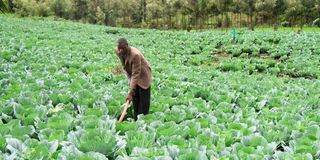Boost for farmers as seed excellence centre takes root

Victor Rono weeds his cabbages in his Njoro farm. Programmes for improving Africa’s seed systems by many actors remain uncoordinated, leading to neglect of important elements.
Small-scale farmers on the continent stand a high chance of lifting themselves from poverty and hunger after the Alliance for a Green Revolution in Africa (Agra) trained 653 scientists to produce high quality seeds.
The scientists have developed and released varieties that will see smallholder farmers increase their harvest, incomes and help in the attainment and sustenance of a uniquely African green revolution.
The new seed varieties are also expected to protect the environment and aid millions of farmers adapt to climate change.
Agra Deputy Vice-President George Bigirwa said the Centre of Excellence for Seed Systems in Africa (Cessa) plays a key role in developing the seed industry and companies.
“We have trained more than 152 technicians who are playing a significant role in variety turnover. We have also helped to establish a seed training institute at the University of Nairobi,” Dr Bigirwa said in a presentation at the 23rd Africa Seed Trade Association Congress in Dakar, Senegal, last month.
The other Cessa milestone is the breeding of 685 climate-smart and resilient varieties that have already been released to the market.
Some 60 per cent is now commercialised, Dr Bigirwa said.
“We have replaced old varieties and observed a yield increase of more than three tonnes per hectare from just 1.5,” he added.
The revolution has led to the establishment of 110 Seed Small and Medium Enterprises, up from 11 in 2006.
These include home-grown companies producing 70 per cent of seed grown in their countries, thus saving on foreign exchange as there are fewer imports than before.
Dr Bigirwa said the volume of seed produced has increased to 604,707 tonnes from 2,000 in 2006, benefiting 24 million smallholder farmers.
He added that the programme has attracted more seed companies that have invested around $300 million in the technology.
In turn, more than 40,000 agro-dealing firms have been established, including close to 1,000 Village-Based Advisers (VBAs) and 1,080 hubs.
It has reduced the distance between agro-dealers from 30 kilometres to just eight.
“The policy reforms, variety release and marketing, liberalisation of early generation seed production, private inspection, plant breeding rights attracting regional companies and multinationals and access to public varieties and royalties are additional benefits as a result of a vibrant Cessa,” Dr Bigirwa said in his presentation.
He added that while progress has been made in the seed industry in Sub-Sahara, programmes for improving Africa’s seed systems by many actors remain uncoordinated, leading to neglect of key elements.
“It is difficult to get evidence-based data and information for decision-making and technical advice and support for the implementation of the improved system,” Dr Bigirwa said.
“There is little collaboration to speed up technology adoption – low investment in research and development.”
Dr Bigirwa said there is need for a one-stop centre (the Cessa) to accelerate the building of functional seed systems that will compete effectively with the rest of the world.
Other challenges facing smallholder farmers are the growing old varieties, shortage of early generation seeds, weak National Agricultural Research Systems, low quality, counterfeit seed frequently planted by farmers and regulatory and legal frameworks not sufficiently fit for purpose, Dr Bigirwa added.
The other bottlenecks are weak government regulatory agencies, lack of capacity to adhere to global quality standards, donors and development partners focusing on a few seed system elements, neglected and uncoordinated seed investments and lack of solid evidence and technical expertise to know what is and what is not working.
But all is not lost as there has been progress in the last two decades in many countries. Governments have liberalised their seed industries, primarily via policy and regulatory aspects.
“Many private seed companies – local, regional and multinational – are participating. Seed production volumes are showing material increases, particularly for hybrid maize, small grains and legumes and distribution networks making seed available in rural areas,” he said.
The business is also booming due to increased participation of local seed companies. Some seeds are beginning to cross borders with increasing frequency.
Other notable success stories are the many policy reforms already implemented: variety release, authorised inspection, plant breeding rights, early generation seed production, access to public varieties and seed company branding and marketing.





